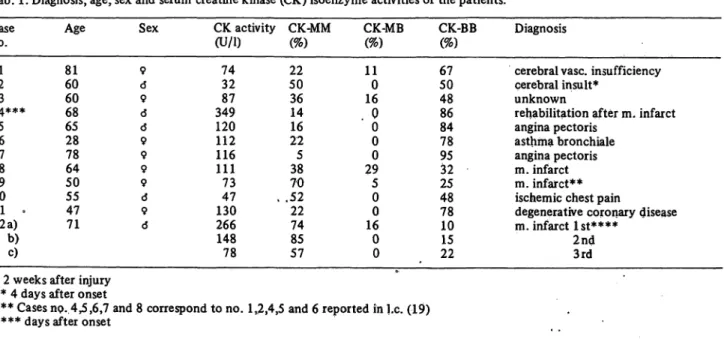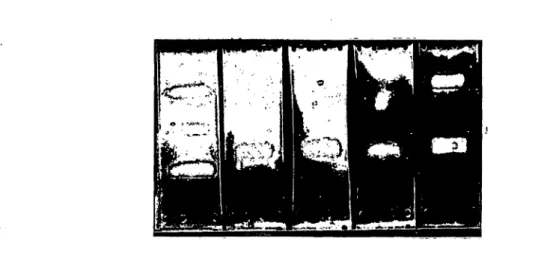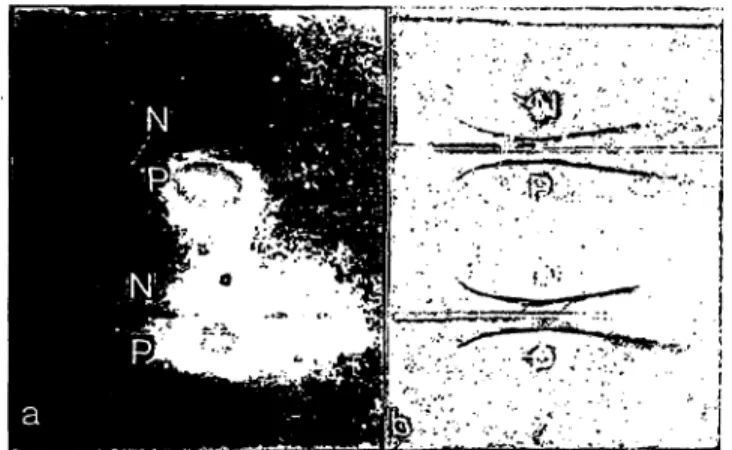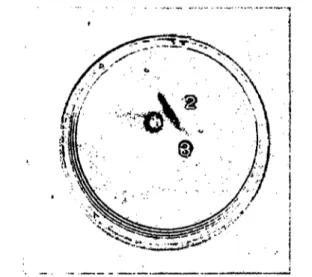Jockers-Wretou and Plessing: Creatine kinase-BB complex with immunoglobulins G and A 731 J. Clin. Chem. Clin. Biochem.
Vol. 17,1979, pp. 731-737
Atypical Serum Creatine Kinase Isoenzyme Pattern Caused by Complexing of Creatine Kinase-BB with Immunoglobulins G and A1),2)
By Evangelia Jockers-Wretou and Elisabeth Plessing
Institut für Organische Chemie, Biochemie und Isotopenforschung der Universität Stuttgart (Received June 21/August l, 1979)
In commemoration of Professor Dr. Gabor Szasz
Summary: 12 cases are described, which show high serum creatine kinase-BB levels, as well as atypical creatine kinase activity band located between normally migrating creatine kinase-MM and creatine kinase-MB. It is shown that the altered properties of the serum creatine kinase-BB, namely its molecular size, heat resistance, electrophoretic mobility, but not its immunological behavior, are caused by complexing with kappa-chains of immunoglobulins G or A. The complex occurring in vivo could also be produced in vitro by using purified patients' IgG and human creatine kinase- BB.
The interaction of creatine kinase-BB with immunoglobulins possibly protects the enzyme against intravascular degradation in vivo, and may therefore account for the high creatine kinase-BB levels observed in these patients.
Atypisches Isoenzymmuster von Kreatinkinase im Serum infolge Komplexbildung von Kreatinkinase-BB mit Immun·
globulin G und A
Zusammenfassung: Es werden 12 Falle beschrieben, die eine erhöhte Kreatinkinase-BB-Aktivität im Serum als auch eine atypische Kreatinkinase-Bande zwischen Kreatinkinase-MM und Kreatinkinase-MB aufweisen. Es wird gezeigt, daß die veränderten Eigenschaften der Serum-Kreatinkinase-BB, nämlich Molekulargewicht, Hitzestabilität, elektro- phoretische Mobilität, aber nicht das immunologische Verhalten, auf die Bindung des Enzyms an kappa-Ketten der Immunpglobuline G und A zurückzuführen sind. Der in vivo auftretende Komplex konnte auch in vitro reproduziert werden und zwar mit gereinigtem Patienten-IgG und humaner Kreatinkinase-BB.
Die Bindung zwischen Kreatinkinase-BB und Immunoglobulinen schützt möglicherweise das Enzym in vivo gegen intraväsale Degradation und könnte somit die bei diesen Patienten auftretende erhöhte Kreatinkinase-BB-Aktivität hervorrufen.
Introduction 2. unusually high concentrations of creatine kinase-BB Occurrence of the creatine kinase (EC 2.7.3.2) isoensyme 3 appearance of creatine kinase-BB in theand BB (creatine kinase-BB) in patient sera without correlation ^^^
to any specific disease has recently been reported (1 ,2).
It was designated as "idiopathic creatine kinase-BB" (1), The present report was initiated by the hypothesis that or as a 'Variant creatine kinase ispenzyme" (2). The the above mentioned properties of creatine kinase-BB reported cases had three properties in common, namely could be due to interaction of the enzyme with a serum
factor, the results of 1 2 cases showing atypical iso- 1 . an atypical ereatine kinase activity band located enzyme pattern as well as high creatine kinase-BB levels
between normally migrating creatine kinase-MM and in the serum are described.
creatine kinase-MB,
Material and Methods
*i QnnnnrteH hv the Deutsche Forschungsgemeinschaft ' Patients ' sera: The reported cases were detected in several
* ISES* fZSS^^^^^V^ of Clinical hospitals by their abnormally high creatine kinase-MB activities Che^iiltry B?fehton 1979 with the immunoinhibition test (Merck). Serum samples
0340-076X/79/00 1 7-073 1 $2.00
© by Walter de Gruyter & Co. · Berlin · New York
at 4 °C after addition of 2-mercaptoethanol (final concen- tration 20 mmol/1).
Enzyme assay: Creatine kinase activity measurements were made at 25 °C by the RosalkiOliver method (3) using the kit "CK-NAC-activated" (Boehringer, Mannheim), the reaction was monitored with an Eppendorf photometer at 365 nm.
Creatine kinase isoenzyme measurements were done by the immunotitration assay developed in this laboratory and modified as reported previously (4,5), using purified IgG from sheep anti- sera against human creatine kinase-MM and creatine kinase-BB (Merck, Darmstadt). Creatine kinase-BB activity in column eluates was assayed by the immunoinhibition test "CK-MB, NAC activated" (Merck). The results were not multiplied by two (6).
Electrophoresis was performed at 4 °C on cellulose acetate strips (Macherey & Nagel, Düren) in 30 mmol/1 Veronal buffer, pH 8.6 at 200 V for one hour. Creatine kinase activity bands were visualized by overlaying the membranes with an agarose-substrate mixture and incubating for 30-60 min at 37 °C. The strips were dried, viewed in UV-light and finally stained with Coomassie Brillant Blue G 250 (Serva, Heidelberg) (2.5 g/1 in methanol:
water: acetic acid, volumes 5 + 5 + 1). Isoelectric focussing studies were performed on Ampholine PAG-plates (LKB, Karls- ruhe), pH 3.5-9.5, with a Desaga apparatus, for 1.5 hour. After washing in distilled water for 15 min the polyacrylamide gel- plates were stained for creatine kinase activity as described above.
Creatine kinase isoenzymes: Crystalline creatine kinase-MM from human muscle was purified as reported previously (4).
Human brain obtained at autopsy was used as source of creatine kinase-BB. Extracts were made in Tris/HCl buffer pH 8.0 (50 mmol/1, 1 mmol/1 EDTA, 10 mmol/1 KC1, 20 mmol/1 2-mercaptoethanol). The enzyme was partly purified by (NH^- SO4-fractionation and chromatography on Sephadex-£-200 (Pharmacia, Sweden). Hybridization of creatine kinase-MM and creatine kinase-BB was performed in 6 mol/1 urea. After dialysis against Tris-buffer pH 8.0 (50 mmol/1,1 mmol/1 EDTA, 20 mmol/12-mercaptoethanol) the relative isoenzyme concen- trations were estimated immunologically. The isoenzyme mix- ture was diluted in normal heat-inactivated serum (serum matrix) and used as a control for the electrophoretic runs.
were purified from the patients' sera on a Protein A-Sepharose CL-4B column (Pharmacia), using an acid eluent (0.1 mol/1 glycine/HCl, pH 3.0) (7). the eiuate was immediately neu- tralized and concentrated through selectron ultramembranes (Schleicher & Schüll, Dassel). The concentration of the purified IgG was estimated by its absorbance at 280 nm, taking A i^ = 14.6 (8).
280
Immunological techniques: Double diffusion, immunoelectro- phoresis and two dimensional "rocket" immunoelectrophoresis were carried out on agarose gels (8 g/l) according to the corre- sponding techniques by Ouchterlony (9), Grabar (10) and Laurett (11). The agarose plates were washed twice in 9 g/l NaCl and stained for creatine kinase activity as described for the electro- pherograms. Control sera and antisera against human plasma proteins were purchased from Behringwerke.
Results
Age, sex, diagnosis and creatine kinase isoenzyme serum activities of the reported cases are summarized in table 1.
Creatine kinase serum activity varied from 32 to 349 U/l and the relative creatine kinase-BB was 10-95 % (16—300 U/l). Serum protein electrophoresis was without any particularities. Concentrations of immuno- globulins G, A and M were within normal ranges.
Stability
The serum creatine kinase activity was stable for several days at 25 °C and for at least two months at 4 °C. A remarkable stability was further observed at 37 °C as shown in figure la for case no. 11. In contrast, incubation of human creatine kinäse-BB in serum matrix resulted in approximately 80 % loss of the activity within one hour (fig. 10).
Tab. 1. Diagnosis, age, sex and serum creatine kinase (CK) isoenzyme activities of the patients.
Case no.
21 34*#*
56 78 109 11 .12 a)
b)c)
Age 8160 6068 6528 7864 5055 4771
Sex 9 6 9 6 0 9 9 9 9 d 9 6
CK activity (U/l)
7432 34987 120112 116111 7347 130266 14878
CK-MM (%) 2250 3614 2216 385 .5270 2274 5785
CK-MB (%) 110 16 . 00 00 295 00 160 0
CK-BB (%) 5067 4886 8478 9532 2548 7810 1522
Diagnosis
cerebral vase, insufficiency cerebral insult*
unknown
rehabilitation after m. infarct angina pectoris
asthma bronchiale angina pectoris m. infarct m. infarct**
ischemic chest pain
degenerative coronary disease m. infarct 1st****
2nd3rd
* 2 weeks after injury
** 4 days after onset
*** Cases no. 4,5,6,7 and 8 correspond to no. 1,2,4,5 and 6 reported in I.e. (19)
**** days after onset
J. Clin. Chem. Clin. Biochem. / VoL 17,1979 / No. 11
Jockers-Wretou and Plessing: Creatine kinase-BB complex with immunoglobulins G and A 733
801
Fig. 1. Thermal stability of aeatine kinase activity at 37 °C.
α) serum no. 11,0) human creatine kinase-BB in serum matrix (100 U/l). (Aliquots were sampled for enzyme assay at the times shown). All points are means of three estimations with the representative SD shown.
Immunotitration assay
The immunotitration curves of serum no. 11 and of native creatine kinase-BB in a serum matrix against anti- human creatine kinase-BB immunoglobulins are compa- red in figure 2. Slope and titration point of both curves are very similar (with respect to the relative creatine kinase-BB in the serum). A slight difference was obser- ved as increasing amounts of antibody resulted in an
increase of the residual activity in the patient serum curve.
Electrophoresis: Electrophoretic patterns of some serum samples are shown in figure 3. A single creatine kinase activity band in the 0-globulin region was located between normally migrating creatine kinase-MM and creatine kinase-MB, except for case no. 5. The creatine kinase activity band migrated in this serum very close to the creatine kinase-MB band of the control. The cathodal band corresponding to creatine kinase-MM was observed in some sera (9 arid 10). In many cases, however, the MM-band was not always detectable as indicated by the
20
0 50 100 Anti-Creatine kinase ΘΒ IgG [μ\]
Fig. 2. Immunotitration assay of a) serum no. 11 aeatine kinase activity and β) human creatine kinase-BB in serum matrix.
Aliquots of the patient's serum (50 mil) and of human creatine kinase-BB in serum matrix (40 mU), both contain- ing 3.5 % polyethyleneglycol, were incubated with sheep IgG against human creatine kinase-BB. Tris buffer, pH 8.0
(0.05 mol/1; 1 mmol/1 EDTA, 20 mmol/1 2-mercaptoetha- nol) was added to a final volume of 450 μΐ. The residual activity is expressed as a percentage of the control after incubation (l h 25 °C) and centrifugation.
dashed lines, or it was even totally undetectable. Case no. 12 (not shown) revealed the atypical band and a normally migrating creatine kinase-MB band as well.
Isoelectric focussing studies showed an analogous behavior. Creatine kinase activity bands were located at the position of creatine kinase-MM and between creatine kinase-MM and creatine kinase-MB (pH 5.6- 6.8). Furthermore, a strong naturally occurring fluorescent band was seen at pH 4.5, the isoelectric point of normally migrating creatine kinase-BB.
Increasing amounts of native creatine kinase-BB were added to a constant volume of the patients' sera. Sub- sequently, the samples were analyzed electrophoretic- ally and assayed for creatine kinase activity. A shown in figure 4, the exogenous creatine kinase-BB migrated first to the same position as the atypical band. Further addition of creatine kinase-BB revealed the anodically
Isoenzyme BB
MB MM Start
1=1
1=1
cm a CZZI11·=-·=. £— | r— ^1
V
r~D
/R\
=
/??\
=3
/ίΪΝ
®
Control
Fig. 3. Electropherograms of creatine kinase isoenzymes in some serum samples.
J.Clin.Chem.Clin.Biochem./Vol. 17,1979/No. 11
Fig. 4. Electropherogram of serum no. 7 after addition of increasing amounts of human creatine kinase-BB.
Exogenous creatine kinase-BB was added to 100 μΐ serum at the following concentrations. Left to right: control, no. 7, no. 7 with 6 mU creatine kinase-BB, no. 7 with 30 mU creatine kinase-BB, no. 7 with 120 mil creatine kinase-BB.
migrating creatine kinase-BB in addition to the atypical band. The measured creatine kinase activity of the samples was compared with their theoretical activity as calculated by addition of the endogenous and exo- genous enzyme activities. This measured activity was 30 % less than the calculated activity in all cases. These results indicated the presence of a serum factor capable of forming a stable creatine kinase-BB complex with a limited creatine kinase-BB activity.
Efforts to precipitate the creatine kinase-BB factor complex with anti-human creatine kinase-BB serum failed. In contrast, exogenous added creatine kinase-BB migrated normally after the patients' sera were treated with antiserum against human plasma proteins. This indicated the factor(s) to be a normal component of human serum.
Column chromatography:
Two peaks showing creatine kinase activity were ob- tained after serum no. 11 chromatography on Sephadex G-200 (fig. 5). A small peak (II) corresponding to a molecular mass of 80 000 was identified as creatine kinase-MM. A second peak (I) of higher molecular mass (240 000) exhibited only creatine kinase-BB activity.
Immunological studies
The Laurell technique was used to analyze the eluate from the Sephadex column containing creatine kinase- BB activity, using a polyvalent antiserum against human serum proteins. When stained for creatine kinase activity one of the precipitin peaks showed strong fluorescence. The corresponding serum protein was identified as IgG by specific anti-IgG serum. All patients' sera assayed by this technique demonstrated a fluorescent precipitin peak of IgG, except case no. 5.
In this case the complexing protein was identified as IgA, as shown in figure 6.
30 40 50 Fraction number
Fig. 5. Elation pattern of serum no. 11 creatine kinase activity from a Sephadex G-200 column. 3 ml serum no. 11 were applied to the column and eluted with Tris buffer pH 8.0 (0.05 mol/1,1 mmol/1 EDTA, 20 mmol/1 2^mercapto- ethanol). Fractions were assayed for total creatine kinase activity (Δ Δ) and for creatine kinase-BB activity (o o) using the immunoinhibition assay. Column dimensions: 25 X 850 mm, void volume: 93 ml, fraction volume: 1.6 ml.
It is noteworthy that only one side of the peak shows creatine kinase activity. Figure 7 demonstrates the patterns observed in the technique of Grabar for two other cases. Precipitiri arcs produced by immuno^
electrophoresis of the patients' sera versus specific anti-human-K-L-chain serum manifested creatine kinase activity. Fluorescence could not be observed by using anti-human-X-L-chain serum.
\ Complexing in vitro
Increasing amounts of purified IgG from serum no. 11 were added to a constant concentration of creatine kinase-BB, thus simulating an iramunotitration assay.
J. Clin. Chem. Clin. Biochem. / Vol.,17,1979 / No. 11
Jockers-Wretou and Plessing: Creatine kinase-BB complex with immunoglobulins G and A 735
Electrophoresis of the samples revealed the "atypical"
band of the IgG-creatine kinase-BB complex formed in vitro (fig. 8). The titration point was estimated from the IgG concentration required to complex all the creatine kinase-BB present; this value was 18.6 U/g IgG, representing a molecular ratio IgG: creatine kinase- BB = 9000:1, assuming 320 U/mg for the specific activity of pure creatine kinase-BB.
The interaction between creatine kinase-BB and the purified IgG was further studied using the Ouchterlony
technique. As shown in figure 9 the precipitin line between creatine kinase-BB and anti-creatine kinase- BB serum was not disturbed by the presence of the patient's IgG.
This result, and the observation that the purified IgG slightly inhibited human creatine kinase-BB as well as creatine kinase-MM, both to the same extent, provided strong evidence for a rather nonspecific protein-protein complex.
Fig. 6.£tfnre//-electropherogram stained for creatine kinase activity. Antigen: 15 μΐ of serum no. 5.
Antiserum: anti-human IgA serum; concentration on the plate 5 ml/1.
Fig. 7. Immunoelectrophoresis pattern of serum no. 6 (top) and serum no. 8 (bottom) versus monospecific anti-IgG antiserum.
P: patient serum, N: control serum,
a) slide stained for creatine kinase activity b) slide stained with Coomassie BB.
Isoenzyme BB MB
MM _ Start"
cm
®
In vitro interaction of purified patient's IgG with human creatine kinase-BB. Increasing amounts of purified IgG (10.7 mg/ml) were added to 35 mU creatine kinase-BB in Tris standard buffer pH 8.0
• . Λ , j . j A\ «,,;+Vi in
a) «ratine Unas* BB without any IgG added d) with 100 ;1 IgG 0 with 300 ,, IgG
J. Ctoh Chem, din. Biochem. / Vol. 17, 1979 / No. 11
Fig. 9. Double immunodiffusion plate stained for creatine kinase activity.
1: human creatine kinase-BB, 2: purified IgG against creatine kinase-BB, 3: purified IgG of serum no. 11.
Discussion
The present results demonstrate that the atypical creatine kinase isoenzyme pattern observed in patients with high creatine kinase-BB levels was due to complexing of creatine kinase-BB with the patients' immunoglobulins. Urdal & Laudaas have come to similar conclusions by using other techniques (20).
In 11 out of 12 cases studied, immunoglobulin G was the complexing factor. In one case creatine kinase-BB was linked to IgA.
The creatine kinase-BB activity in the complex was extremely stable at 25 °C, 4 °C and 37 °C as compared with the activity of native creatine kinase-BB stored under similar conditions. These results could partly explain the high concentration of creatine kinase-BB and its prolonged appearance in the sera. The immuno- titration curve and the formation of the complex between purified IgG and exogenous creatine kinase- BB in vitro both indicated that a normal creatine kinase- BB protein was involved in the complex. On the other hand the patients' immunoglobulins revealed normal precipitin arcs as compared with control serum (fig. 7).
The stoichiometric composition of the complex was estimated to be 1 : 1 from the molecular mass obtained by gel filtration. The complexing capacity (mol IgG:
mol creatine kinase-BB) of the purified IgG was found to be 9000:1 in the in vitro assay for case no. 11. Thus, one out of 9000 molecules of that patient's IgG is able to bind one molecule creatine kinase-BB. This ratio may, however, vary from case to case. The complexing ability of the immunoglobulins was further restricted to the /c- L-class.
The assumption of antibody formation against creatine kinase-BB could be excluded on the basis of the results obtained by the immunotitration and the Ouchterlony technique.
Complexing of immunoglobulins with enzymes is a well known phenomenon in the clinical literature. Several reports have described complex formation between IgG and human enzymes, such as aspartate aminotrans- ferase, lactate dehydrogenase and.alkaline phosphatase (12,13,14). Binding may even occur between immuno- globulins and plasma proteins (15).
Prabhakaran et al. recently reported the interaction of human IgG with human creatine kinase-BB (16). The described complex, however, is clearly distinct from that reported in this paper, having a higher molecular mass (825 000). Moreover, the lability of the high mole- cular mass complex, discussed by the authors as a possible route for creatine kinase-BB intravascular cata- bolism, contrasts strongly with the stability of the 1:1 complex, discussed as a possible reaspre for the prolonged occurrence of creatine kinase-BB in the patients' sera.
Atypical creatine kinase isoenzyme patterns have often been reported. Velletri et al. described creatine kinase - MM linked to /Mipoprotein and migrating between creatine kinase-MM and creatine kinase-MB (17). A similar mobility characterized the atypical pattern reported by Sax et al. (18).
Previously we reported high creatine kinase-BB levels present during 10 months in the serum of a patient suffering from a nervous system disorder. The data were obtained by immunotitration (5). On the basis of the present results, complexing of creatine kinase-BB with immunoglobulins might also have caused the stability of creatine kinase-BB in that case. The fre- quency of the "idiopathic" creatine kinase-BB presence in patients' sera has been estimated to be 1:1000 (1) or 1:100 (2).
In a recent study we demonstrated that the detection and adequate estimation of the creatine kinase iso- enzymes in these atypical sera-can only be achieved
J. Clin. Chem. Clin. Biochem, / Vol. 17,1979 / No. 11
Jockers-Wretou and Piessing: Creatine kinase-BB complex with immunoglobulins G and A 737 by using immunologieal methods able to distinguish
between creatine kinase-MB and creatine kinase-BB (19). Even the immuno inhibition assay (Merck) can lead to misinterpretation, especially when small amounts of creatine kinase-BB are present and multiplication by 2 results in a "normal" creatine kinase-MB activity.
The main question, as to the tissue of origin of the high creatine kinase-BB serum levels, remains, however, un- solved. Since the nervous system and gastrointestinal tract are the tissues with the highest creatine kinase-BB concentration, they are both likely to be the source of creatine kinase-BB. On the other hand, only one common denominator could be found, namely the ability of the patients' immunoglobulins to complex creatine kinase- BB.
The thermal stability of the complexed enzyme in vitro reasonably suggests that creatine kinase-BB is protected in a similar way against intravascular degradation in vivo.
Serum creatine kinase-BB levels depend thus on the serum concentration of the specific complexing immuno- globulin L-chains and may reflect a normal cell efflux, rather than any particular tissue or membrane damage.
Acknowledgments
The help of Professor Dr. Dr. H. Wisser, Stuttgart, Professor Dr. H. Lehmann, Marburg, Dr. H. Chemnitz, Hannover and Dr. A Wilhelm, Münster, in supplying serum specimens is gratefully acknowledged. Quantitative serum protein electro- phoreses and estimations of IgG, IgA and IgM were performed at the Dept. of Clinical Chemistry, Robert-Bosch-Krankenhaus, Stuttgart; Head: Professor Wisser.
References
1. Lang, H., Würzburg, K., Neumaier, D., Knedel, H., Prellwitz, W., Kattermann, R., Schlebusch, H. & Schürmann, J. (1978), Klin. Wochenschr. 56, 641-646.
2. Ljungdahl, L. & Gerhardt, W. (1978), Clin. Chem. 24, 832- 834.
3. Rosalki, S. B. (1967), J. Clin. Lab. Med. 69, 696-705.
4. Jockers-Wretou, E. & Pfleiderer, G. (1976), Clin. Chim. Acta 73,183-186.
5. Jockers-Wretou, E., Grabert, K., Müller, E. & Pfleiderer, G.
(1976), Clin. Chim. Acta 73, 183-186.
6. Würzburg, K., Hennrich, N., Lang, H., Prellwitz, W., Neu- meier, D. & Knedel, M. (1976), Klin. Wochenschr. 54, 357-360.
7. Hjelm, H., Hjelm, K. & Sjöquist, J. (1972), FEBS Lett. 28, 8. Robbins, J. B. & Schneerson, R. (1974), Methods in Enzy-31.
mology 34, 725.
9. Ouchterlony, O., (1948), Acta Pathol. Microbiol. Scand. 25, 186-191.
10. Graber, P. & Williams, C. A. (1953), Biochim. Biophys. Acta 70,193.
11. Laurell, C. B. (1965), Anal. Biochem. 10, 358-361.
12. Konntinen, A., Murros, J., Qjala, K. (1978), Clin. Chim.
Acta £4,145.
13.Nagamine,M. (1972), Clin. Chim. Acta 36,139-144.
14. Nagamine, M. & Okhuma, S. (1975), Clin. Chim. Acta 65, 39-46.
15. Laurell, C. B. (1970), Immunochemistry 7,461-465.
16. Prabhakaran, V., Nealon, D. A. & Henderson, A. R. (1979), Clin. Chem. 25, 112-116.
17. Velletri, K., Griffiths, W. C. & Diamond, I. (1975), Clin.
Chem. 27,1837-1838.
18. Sax, S. M., Moore, J. J., Giegel, J. L. & Welsh, M. (1976), Clin. Chem. 22, 87-91.
19. Chemnitz, G., Jockers-Wretou, E., Schmidt, E., Schmidt, F. W. & Lobers, J. (1979), J. Clin. Chem. Clin. Biochem.
77,725-729.
20. Urdal, P. & Landaas, S. (1979), Clin. Chem. 25, 461-465.
Dr. Evangelia Jockers-Wretou
The Hellenic National Research Foundation Biological Research Center
48, Vassileos Konstantinou Avenue GR-508 Athens
Greece
J. Clin. Chem. Clin. Biochem. / Vol. 17,1979 / No. 11




